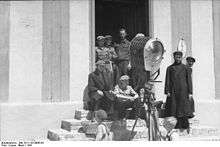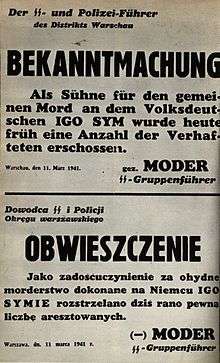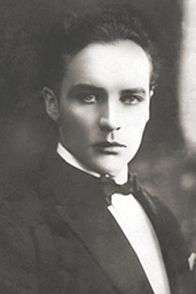Igo Sym
| Igo Sym | |
|---|---|
|
Sym about 1937 | |
| Born |
Karol Juliusz Sym July 3, 1896 Innsbruck, Austria-Hungary |
| Died |
March 7, 1941 (aged 44) Warsaw, General Government |
| Occupation | Soldier, film actor, later entertainer and Gestapo agent |
| Years active | 1925–1941 |
Karol Juliusz "Igo" Sym (July 3, 1896 – March 7, 1941) was an Austrian-born Polish actor and collaborator with Nazi Germany. He was killed in Warsaw by members of the Polish resistance movement.
Early career
Sym was born in Innsbruck, the son of Anton Sym from Niepołomice in Galicia and his wife Julia (née Sepp). It is not known why he had chosen to settle in Poland or when exactly it happened. During World War I he served in the Austro-Hungarian Army, becoming a lieutenant. After the war, he served in the Polish Armed Forces infantry in the rank of a First Lieutenant, until in 1921 he took up the job of a bank attorney.
Sym's movie debut took place in 1925, in a film called Vampires of Warsaw (of which no copy is known to exist). Handsome and athletic, he often played aristocrats and army officers. In 1927 he left for Vienna, where he signed a contract with the Sascha-Film production company. In late 1920s Sym worked mainly in Austria and Germany, appearing with such actresses as Marlene Dietrich, Anny Ondra and Lilian Harvey in silent movies like Die Pratermizzi or Café Elektric directed by Gustav Ucicky.
At the beginning of the 1930s Sym returned to Poland and settled in Warsaw. Unexpectedly, he gave up most of movie theater productions, concentrating activities on stages of Warsaw’s theatres. He entertained by singing, dancing and playing the musical saw.[1]
Collaboration
After the Invasion of Poland starting on 1 September 1939, Sym stayed in German-occupied Warsaw. Known before the war for his pro-German stance, the actor registered with the Volksliste and thereby was declared a Volksdeutscher.[2] Due to his widespread fame, the Germans regarded him as a crucial element of legitimization of the new authorities. So, the propaganda department of the General Government gave him the post of the director of the Theater der Stadt Warschau, the former Polish Theatre in Warsaw. Sym was the director of the Nur für Deutsche cinema, the Helgoland (former Palladium), and licensee at the Teatr Komedia.
Some time in late 1939, Sym became a Gestapo agent. Also, according to the preserved documents, the actor had been cooperating with Berlin before September 1, 1939. At the beginning of the war he helped to organize a trap, in which Hanka Ordonówna was caught (Ordonówna had been Sym's pre-war partner on the screen and his friend from Warsaw's theaters). Polish resistance quickly found out about this, and a group of agents, led by “Teatr Komedia” actor Roman Niewiarowicz, started to trace his activities.

On 10 October 1941 the film Heimkehr debuted in Berlin's Ufa-Palast am Zoo cinema. The Nazi propaganda movie directed by Gustav Ucicky told a story about the pre-1939 German minority in Polish Volhynia resettled in the course of the Nazi–Soviet population transfers. The Germans, presented as noble, peace-loving people, were brutally persecuted by vicious Poles. In the final scene, Polish soldiers lead arrested Germans to execution; however, Wehrmacht airplanes and tanks appear, saving the whole community. Igo Sym did not perform in this film, but he actively cooperated in the production, casting Polish actors more or less willing to take part. Several actors refused, including Kazimierz Junosza-Stępowski. Finally, he found some individuals, who were accepted by director Ucicky. After the war, these actors were punished for cooperating with the Germans.
His collaboration contrasts with the behaviour of his younger brother Ernest, who during his official activities as a chemist, clandestinely manufactured explosives for the Home Army.
Assassination
In early 1941, the headquarters of the underground Polish resistance group Union of Armed Struggle (ZWZ) decided to liquidate the collaborator. Sym’s behavior was loudly trumpeted by the Nazis, and his assassination would show the Poles that the underground movement was active, always ready to punish all traitors. At first, the ZWZ planned to poison the actor, but later decided to shoot him instead.
When Roman Niewiarowicz informed the ZWZ that Sym would leave for Vienna on March 8, 1941, the resistance decided to kill the collaborator before that date. To carry out the assassination, the ZWZ selected the commando group “ZOM” of the Intelligence Department of the Warsaw-City District, led by Bohdan “Szary” Rogoliński.
At 7:10 a.m. on March 7, 1941, two Polish agents knocked at the door of Sym's 4th floor apartment at 10 Mazowiecka Street in Warsaw. The agents – Rogoliński and Roman “Srebrny” Rozmiłowski – told Sym that they were postmen carrying a dispatch. Both were covered by Wiktor “Mały” Klimaszewski. On opening the door, Sym was asked to confirm his name, which he did. One of the agents then shot Sym dead with a Vis pistol.
Aftermath

On the same day, German loudspeakers on the streets announced that hostages had been taken as revenge for Sym’s death. Then, posters signed by a Dr. Ludwig Fischer appeared on the walls stating that more hostages would be taken and curfew would be enforced from 8 p.m. to 5 a.m.
Fischer threatened to shoot all hostages unless those responsible for assassination were found. All theatres were closed, and about 120 people were arrested, including teachers, physicians, lawyers and actors. The population of Warsaw was given three days to find Sym's murderers.
As nobody was found, on March 11 in Palmiry, 21 hostages were executed. Several actors were also arrested and sent to Auschwitz, among them such notable figures as directors Stefan Jaracz and Leon Schiller.[3]
Selected filmography
- Wampiry Warszawy (1925)
- Die Pratermizzi (1926)
- Café Elektric (1927)
- Dive (1928)
- The Model from Montparnasse (1929)
- The Mistress and her Servant (1929)
- My Sister and I (1929)
- The Right to Love (1930)
- Vienna, City of Song (1930)
- Moritz Makes his Fortune (1931)
- Pałac na kółkach (1932)
- Szpieg w masce (1933)
- A Diplomatic Wife (1937)
- Złota Maska (1939)
- Żona i nie żona (1939)
References
- ↑ Thomas Staedeli Portrait of the actor Igo Sym.
- ↑ Bernhard Chiari; Jerzy Kochanowski (2003) Die polnische Heimatarmee, p. 449, Oldenbourg Verlag, ISBN 978-3-48656-715-1 (German)
- ↑ Bogusław Kunach (01/12/2003). "Być tym, co słynie. Igo Sym" (in Polish). Gazeta Wyborcza. Archived from the original on March 6, 2012. Retrieved 02/05/2010. Check date values in:
|access-date=, |date=(help)
External links
- Egzekucja Igo Syma — article at e-teatr.pl (Polish)
- Igo Sym at filmpolski.pl (Polish)
- Portrait of the actor Igo Sym by Thomas Staedeli at cyranos.ch
- Trials of German Major War Criminals: Volume 7 at www.nizkor.org
- Igo Sym at the Internet Movie Database
- Photographs and literature
